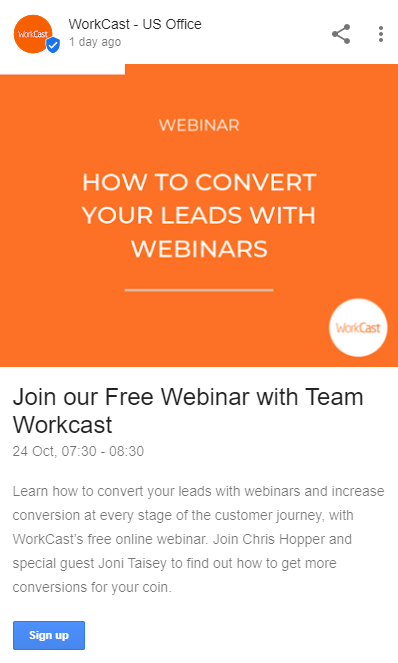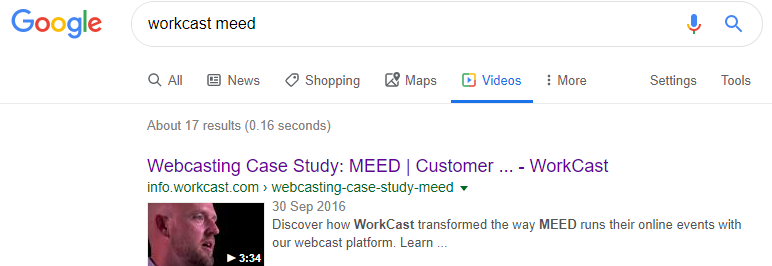So, you’re thinking of hosting a webinar - that's great! You’ve come to the right place. But, allow me pose a question: how do you ensure that the right people find your webinar online?
What I’m talking about is the visibility of your webinar in search engine results pages (SERPs) like Google and Bing - specifically, your webinar’s organic visibility. This can also be defined as webinar SEO, which stands for webinar Search Engine Optimization.
Traditionally, SEO is the practice of increasing the quantity and quality of traffic to your website through organic search engine results. As such, the same practices can be applied to your webinars and accompanying landing pages, which is why we have compiled a list of ways in which you can improve your webinar SEO.
By adhering to these webinar SEO best practices, you will improve organic traffic, rankings for relevant keywords and ultimately, increase attendance for your webinars.
Webinar SEO Keyword Research
Just like with SEO best practice, keyword research is essential during the planning stages of your webinar.
Conducting keyword research during the preparation stage will help you to ensure you’re optimizing your webinar title and content for relevant keywords, so you can rank higher in SERPs, increase quality organic traffic to your webinar and drive webinar registrations.
Some useful keyword research tools for webinar SEO include:
- Google AdWords Keyword Planner
- Keywords Everywhere
- Moz Keyword Explorer
- Ahrefs Keywords Explorer
- Google Trends

When conducting keyword research for your webinar, I always suggest creating a dedicated keyword set and then grouping related keywords and keyphrases into smaller sets of similar topics a.k.a topic clusters. You can create a webinar using one of these topic clusters and target all of the related terms in the content and on the accompanying landing pages. This will extend your webinar's reach in the SERPs and increase webinar attendance from organic users.
Optimize Landing Pages for Webinar SEO
Once you’ve conducted your keyword research and segmented your keywords into relevant topic clusters, then it’s time to create your optimized webinar landing pages.
Every webinar requires a registration page, where people can register for the event, so ensure that you optimize content on this page for target keyphrases, such as ‘XXX webinar registration’. As per SEO best practice, on-page optimization involves optimizing the following content elements on and off the page for relevant keywords:

- Meta data i.e. page title and meta description
- H1 tag
- H2 and H3 tags
- On-page body copy
- Internal links
Most importantly, you should ensure that you provide users with all of the relevant information to drive maximum webinar attendance, such as date, time, speakers & presenters, duration and more. All relevant information and content should also be easily readable at a glance to prevent users from bouncing and instead, drive them to convert.
Utilize Google My Business for Webinar SEO
You’re probably wondering how Google My Business can help to increase webinar attendance? The truth is, it’s a platform that many webinar presenters have overlooked in the past.
However, I have been experimenting with Google My Business as another platform to drive organic registrations and traffic to the site and it works. Marketers and businesses who have Google My Business listings can leverage the 'Post' function in the platform to create an event for your webinar for free.
To get started with Google My Business posts for your event, all you need to provide is:
- Optimized event title
- Captivating image or video
- Specific date and time
- Description of the event, with relevant keyphrases throughout
- Link to your registration page, with a tracking code for analytics

Once published, users will be able to see your event whenever they see your business in local search results and seeing as the top 3 results on Mobile are usually local results, you’ll increase your organic webinar reach even further. Just make sure you optimize your event for relevant keyphrases, like ‘webinar event’, to improve your visibility for relevant terms.
Embed Your On-Demand Webinar
On-demand webinars may not drive as much engagement as their live counterparts, but they are the ideal choice for extending the life of your webinar and creating evergreen content.
Once your live webinar is over, I recommend creating a dedicated landing page for the on-demand version of your webinar where you can embed the webinar video, provide users with a summary of the webinar and even provide a transcript. This gives you the opportunity to optimize the content for target keyphrases, so you can rank for relevant search queries.
It’s no secret that SEO is a slow burn and the same holds true when it comes to webinar SEO. And so, ensuring that your webinar content is evergreen, rather than news-based, will allow your dedicated on-demand webinar page to gain SEO authority over time and provide ample opportunity for keyword and keyphrase rankings.
Finally, you can enhance the visibility of your videos on Google by implementing structured data markup on your video pages to help search engines understand when videos appear on a page. This also increases the chances of your webinar video being shown as a rich result in the main Search, Videos Search or Discover page, like the below WorkCast example:

Rich results usually sit in the coveted “position 0”, which means that they sit above the traditional text results in search engines. This makes them more eye-catching, so users are more likely to click through to your result. What does this mean for webinars? It means more organic traffic to your on-demand webinars, increased brand awareness and potential conversions on your site.
Create Good Content to boost Webinar SEO
At the heart of webinar SEO and SEO in general, is the focus on good quality content.
The same should apply to your webinar content - if it’s just time-filling fodder, or if it doesn’t serve the search intent for the queries you’re targeting, then frankly, it’s not good quality content. This also holds true for content you wouldn’t share with a friend or offer additional value when compared with that of your competitors’.
In this instance, I suggest going back to the drawing board and creating webinar content with your audience in mind, as this will not only improve your webinar SEO, but it will promote audience engagement and boost attendance rates.
Considering your target audience first and foremost at every stage of the webinar production process will serve you well when it comes to webinar SEO and achieving success. This is an approach that can and should be adopted to any webinar programme and broader digital marketing strategy.
For example, it would be disheartening to throw a birthday party only to have no one show up and it’s the same for your webinar. By following these simple steps, you can ensure that your webinar reaches the right audience and with the right audience, you will drive increased attendance and audience engagement throughout your webinar.
As cliché as it may sound, when it comes to creating webinars, you need to think outside the box and put your creative cap on. If you’re looking for more creative inspiration, then download our free eBook How to Create Engaging Content for Webinars to learn how to create the kind of content that makes your webinar earn the privilege of everyone’s time.
Learn how to run incredible webinars with our Ultimate Webinar Handbook.
Share this
You May Also Like
These Related Stories

Hosting Pre-Recorded Webinars: The Secret to Webinar Success

Why Do Webinars Fail?


